Unilever's Business Strategy: A Comprehensive Analysis
VerifiedAdded on 2024/05/29
|28
|5687
|68
AI Summary
This report provides a comprehensive analysis of Unilever's business strategy, examining its internal and external environments, competitive landscape, and strategic direction. It utilizes frameworks such as PESTLE, SWOT, Porter's Five Forces, and VRIO to assess Unilever's strengths, weaknesses, opportunities, and threats. The report also outlines a strategic plan for Unilever, incorporating SMART objectives and resource implications to ensure sustainable growth and competitive advantage.
Contribute Materials
Your contribution can guide someone’s learning journey. Share your
documents today.

BUSINESS STRATEGY
Secure Best Marks with AI Grader
Need help grading? Try our AI Grader for instant feedback on your assignments.

Contents
INTRODUCTION................................................................................................................................1
TASK 01............................................................................................................................................2
P1 CAPABILITIES OF UNILEVER BY APPLYING PESTLE AND SWOT FRAMEWORKS......................2
M1 CRITICAL ANALYSIS OF MACRO ENVIRONMENT...................................................................7
TASK 2..............................................................................................................................................9
P2 & M2 ANALYSIS OF INTERNAL ENVIRONMENT AND CAPABILITIES OF UNILEVER.................9
STRATEGIC CAPABILITY..........................................................................................................10
VRIO MODEL..........................................................................................................................11
STRENGTHS AND WEAKNESSES.............................................................................................14
TASK 03..........................................................................................................................................15
P3 & M3 COMPETITIVE MARKET ANALYSIS...............................................................................15
TASK 04..........................................................................................................................................17
CONCLUSION.................................................................................................................................23
REFERENCES...................................................................................................................................24
1
INTRODUCTION................................................................................................................................1
TASK 01............................................................................................................................................2
P1 CAPABILITIES OF UNILEVER BY APPLYING PESTLE AND SWOT FRAMEWORKS......................2
M1 CRITICAL ANALYSIS OF MACRO ENVIRONMENT...................................................................7
TASK 2..............................................................................................................................................9
P2 & M2 ANALYSIS OF INTERNAL ENVIRONMENT AND CAPABILITIES OF UNILEVER.................9
STRATEGIC CAPABILITY..........................................................................................................10
VRIO MODEL..........................................................................................................................11
STRENGTHS AND WEAKNESSES.............................................................................................14
TASK 03..........................................................................................................................................15
P3 & M3 COMPETITIVE MARKET ANALYSIS...............................................................................15
TASK 04..........................................................................................................................................17
CONCLUSION.................................................................................................................................23
REFERENCES...................................................................................................................................24
1
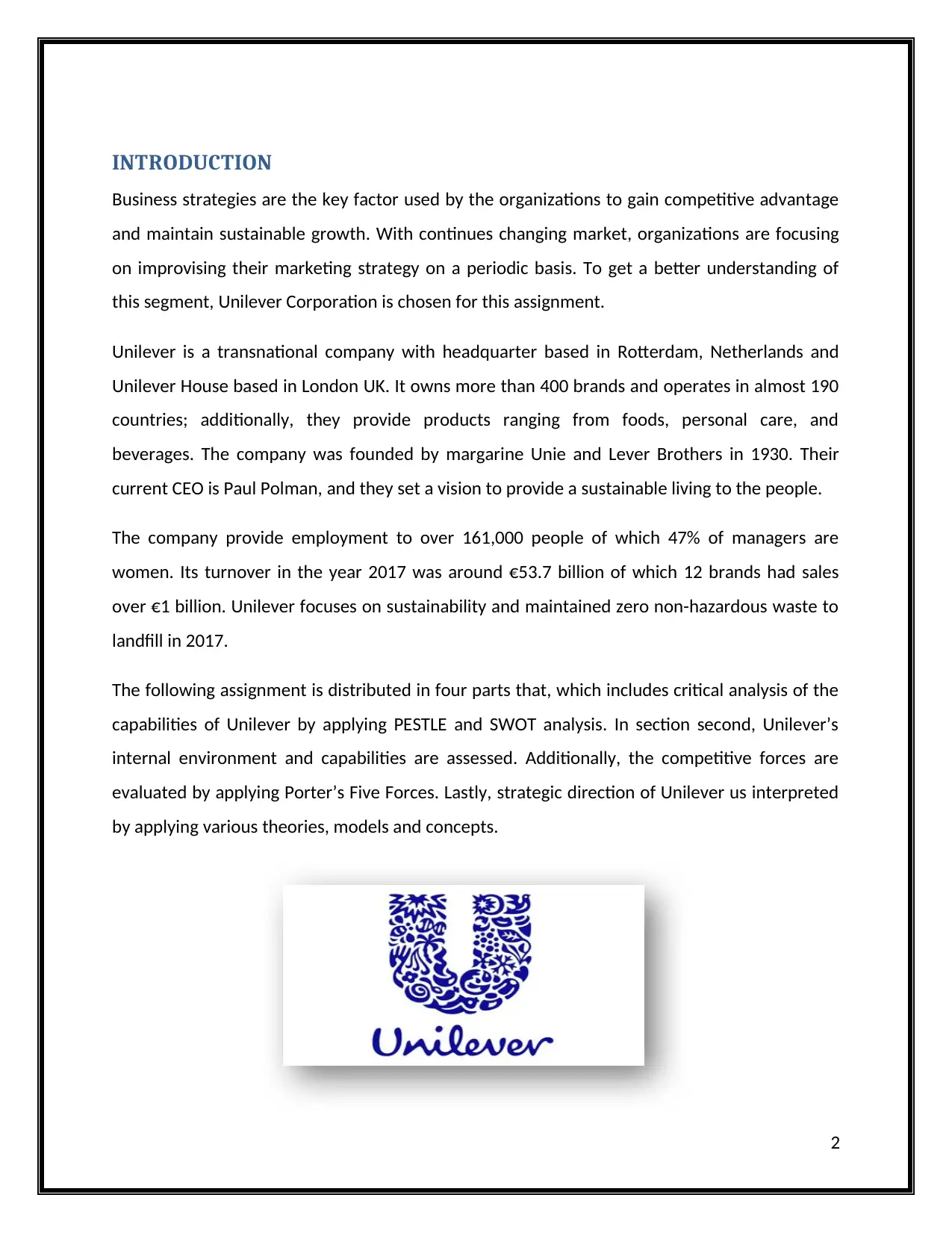
INTRODUCTION
Business strategies are the key factor used by the organizations to gain competitive advantage
and maintain sustainable growth. With continues changing market, organizations are focusing
on improvising their marketing strategy on a periodic basis. To get a better understanding of
this segment, Unilever Corporation is chosen for this assignment.
Unilever is a transnational company with headquarter based in Rotterdam, Netherlands and
Unilever House based in London UK. It owns more than 400 brands and operates in almost 190
countries; additionally, they provide products ranging from foods, personal care, and
beverages. The company was founded by margarine Unie and Lever Brothers in 1930. Their
current CEO is Paul Polman, and they set a vision to provide a sustainable living to the people.
The company provide employment to over 161,000 people of which 47% of managers are
women. Its turnover in the year 2017 was around €53.7 billion of which 12 brands had sales
over €1 billion. Unilever focuses on sustainability and maintained zero non-hazardous waste to
landfill in 2017.
The following assignment is distributed in four parts that, which includes critical analysis of the
capabilities of Unilever by applying PESTLE and SWOT analysis. In section second, Unilever’s
internal environment and capabilities are assessed. Additionally, the competitive forces are
evaluated by applying Porter’s Five Forces. Lastly, strategic direction of Unilever us interpreted
by applying various theories, models and concepts.
2
Business strategies are the key factor used by the organizations to gain competitive advantage
and maintain sustainable growth. With continues changing market, organizations are focusing
on improvising their marketing strategy on a periodic basis. To get a better understanding of
this segment, Unilever Corporation is chosen for this assignment.
Unilever is a transnational company with headquarter based in Rotterdam, Netherlands and
Unilever House based in London UK. It owns more than 400 brands and operates in almost 190
countries; additionally, they provide products ranging from foods, personal care, and
beverages. The company was founded by margarine Unie and Lever Brothers in 1930. Their
current CEO is Paul Polman, and they set a vision to provide a sustainable living to the people.
The company provide employment to over 161,000 people of which 47% of managers are
women. Its turnover in the year 2017 was around €53.7 billion of which 12 brands had sales
over €1 billion. Unilever focuses on sustainability and maintained zero non-hazardous waste to
landfill in 2017.
The following assignment is distributed in four parts that, which includes critical analysis of the
capabilities of Unilever by applying PESTLE and SWOT analysis. In section second, Unilever’s
internal environment and capabilities are assessed. Additionally, the competitive forces are
evaluated by applying Porter’s Five Forces. Lastly, strategic direction of Unilever us interpreted
by applying various theories, models and concepts.
2

TASK 01
P1 CAPABILITIES OF UNILEVER BY APPLYING PESTLE AND SWOT
FRAMEWORKS
Every external factor on which the organizations has no or little control like legal, political,
environmental etc. are considered as the macro environment. It affects the whole economy
rather than a specific sector or organization. To get a better understanding of the external
factors that can have an impact on the Unilever, PESTLE analysis can be conducted. Since the
company operating in over 190 countries and owns over 400 brands, there are several external
factors that have the influence on the productivity and performance of the company. PESTLE
analysis of Unilever is conducted below:
Figure 1: Business Model of Unilever
3
ConsumerInsightCollaborationInnovationSourcingManufacturingLogisticsMarketingSales
P1 CAPABILITIES OF UNILEVER BY APPLYING PESTLE AND SWOT
FRAMEWORKS
Every external factor on which the organizations has no or little control like legal, political,
environmental etc. are considered as the macro environment. It affects the whole economy
rather than a specific sector or organization. To get a better understanding of the external
factors that can have an impact on the Unilever, PESTLE analysis can be conducted. Since the
company operating in over 190 countries and owns over 400 brands, there are several external
factors that have the influence on the productivity and performance of the company. PESTLE
analysis of Unilever is conducted below:
Figure 1: Business Model of Unilever
3
ConsumerInsightCollaborationInnovationSourcingManufacturingLogisticsMarketingSales
Secure Best Marks with AI Grader
Need help grading? Try our AI Grader for instant feedback on your assignments.

POLITICAL
As the company operates in several countries, therefore different laws made by each country
bound it. For instance, the company to avoid legal actions must effectively follow guidelines
provided by food and drug administration of USA and European Commission. Improving free
trade relations and political stability in several countries like India, China etc. has provided an
opportunity to the company to accelerate their business.
On the other hand, political unrest in the European Union and BREXIT has negatively affected
the growth of the company. The supply chain of the company is greatly affected by this political
decision. Since the input cost is raised the company had to increase the rates of their products
significantly, which created conflict. The manufacturing stage is also somewhat affected, as the
company now have to focus on localizing the manufacturing base (Kew, and Stredwick, 2017).
ECONOMICAL
Economic situation around the world affects the performance of the company. Several
economic factors determine the performance of the Unilever such as, increased wages in
developing country has increased the amount of disposable income, that created an
opportunity to their company to increased their sales (Cadle, et al., 2010). This same factor also
acts as a threat since many manufacturing facilities of Unilever is situated in developing nations.
Additionally, the opportunity of expanding business in the developing countries also cause
profit to the business since investing in such nations can ensure higher return rate. Moreover,
the economic stability of the developed nations ensures slow and steady growth in business.
SOCIAL
Unilever owns more than 400 brands, thus maintaining a strong reputation in the market is
essential for them. Their products focus on increasing the daily lifestyle of the consumers and
make them feel better. With the changing, market sociocultural factor creates several
opportunities for the business such as, customers around the world are becoming more health
conscious therefore products that address this factor can be offered. Additionally, the rise in
environmentalist behaviours can also be used for attracting large customer base (Cadle, et al.,
4
As the company operates in several countries, therefore different laws made by each country
bound it. For instance, the company to avoid legal actions must effectively follow guidelines
provided by food and drug administration of USA and European Commission. Improving free
trade relations and political stability in several countries like India, China etc. has provided an
opportunity to the company to accelerate their business.
On the other hand, political unrest in the European Union and BREXIT has negatively affected
the growth of the company. The supply chain of the company is greatly affected by this political
decision. Since the input cost is raised the company had to increase the rates of their products
significantly, which created conflict. The manufacturing stage is also somewhat affected, as the
company now have to focus on localizing the manufacturing base (Kew, and Stredwick, 2017).
ECONOMICAL
Economic situation around the world affects the performance of the company. Several
economic factors determine the performance of the Unilever such as, increased wages in
developing country has increased the amount of disposable income, that created an
opportunity to their company to increased their sales (Cadle, et al., 2010). This same factor also
acts as a threat since many manufacturing facilities of Unilever is situated in developing nations.
Additionally, the opportunity of expanding business in the developing countries also cause
profit to the business since investing in such nations can ensure higher return rate. Moreover,
the economic stability of the developed nations ensures slow and steady growth in business.
SOCIAL
Unilever owns more than 400 brands, thus maintaining a strong reputation in the market is
essential for them. Their products focus on increasing the daily lifestyle of the consumers and
make them feel better. With the changing, market sociocultural factor creates several
opportunities for the business such as, customers around the world are becoming more health
conscious therefore products that address this factor can be offered. Additionally, the rise in
environmentalist behaviours can also be used for attracting large customer base (Cadle, et al.,
4

2010). The company can use methods to minimize its energy usage. Unilever already uses
hybrid transportation system in order to minimize their carbon emission.
TECHNOLOGICAL
The increase in technological advancement creates several opportunities as well as the threat
to the company. Factors like increasing business automation provide an opportunity to the
company to ease up the supply chain process by implementing IT systems. The same factor
raises the threat to the company, since competitors, including the local retailers, can also take
advantage and affect the profitability of Unilever. Increase in the R&D investments causes a
threat to the company as it creates opportunities for the competitors to enter the personal care
industry (Cadle, et al., 2010).
ENVIRONMENTAL
The raised concern about the sustainable growth of the business has created several
opportunities for the business. Unilever can focus on implementing strategies and utilizing
technologies to minimize their carbon emission and energy usage level, in order to, control the
impact of business on the environment. Through corporate responsibility, Unilever can gain
competitive advantage (Kew, and Stredwick, 2017).
LEGAL
Unilever operates in many countries each having different laws and guidelines to follow that
creates difficulty for the business to keep up with different guidelines. Though, this also creates
opportunity, since the company can design complex environmental guidelines. Additionally, the
strong international patent law has provided great opportunity to focus on their R&D sector
and develop new products (Sadgrove, 2016).
In order to get a better understanding of the internal and external factors that have an impact
on the growth of Unilever, SWOT analysis can be conducted that will provide detailed
information about the strength, weaknesses, Opportunities and threats.
5
hybrid transportation system in order to minimize their carbon emission.
TECHNOLOGICAL
The increase in technological advancement creates several opportunities as well as the threat
to the company. Factors like increasing business automation provide an opportunity to the
company to ease up the supply chain process by implementing IT systems. The same factor
raises the threat to the company, since competitors, including the local retailers, can also take
advantage and affect the profitability of Unilever. Increase in the R&D investments causes a
threat to the company as it creates opportunities for the competitors to enter the personal care
industry (Cadle, et al., 2010).
ENVIRONMENTAL
The raised concern about the sustainable growth of the business has created several
opportunities for the business. Unilever can focus on implementing strategies and utilizing
technologies to minimize their carbon emission and energy usage level, in order to, control the
impact of business on the environment. Through corporate responsibility, Unilever can gain
competitive advantage (Kew, and Stredwick, 2017).
LEGAL
Unilever operates in many countries each having different laws and guidelines to follow that
creates difficulty for the business to keep up with different guidelines. Though, this also creates
opportunity, since the company can design complex environmental guidelines. Additionally, the
strong international patent law has provided great opportunity to focus on their R&D sector
and develop new products (Sadgrove, 2016).
In order to get a better understanding of the internal and external factors that have an impact
on the growth of Unilever, SWOT analysis can be conducted that will provide detailed
information about the strength, weaknesses, Opportunities and threats.
5
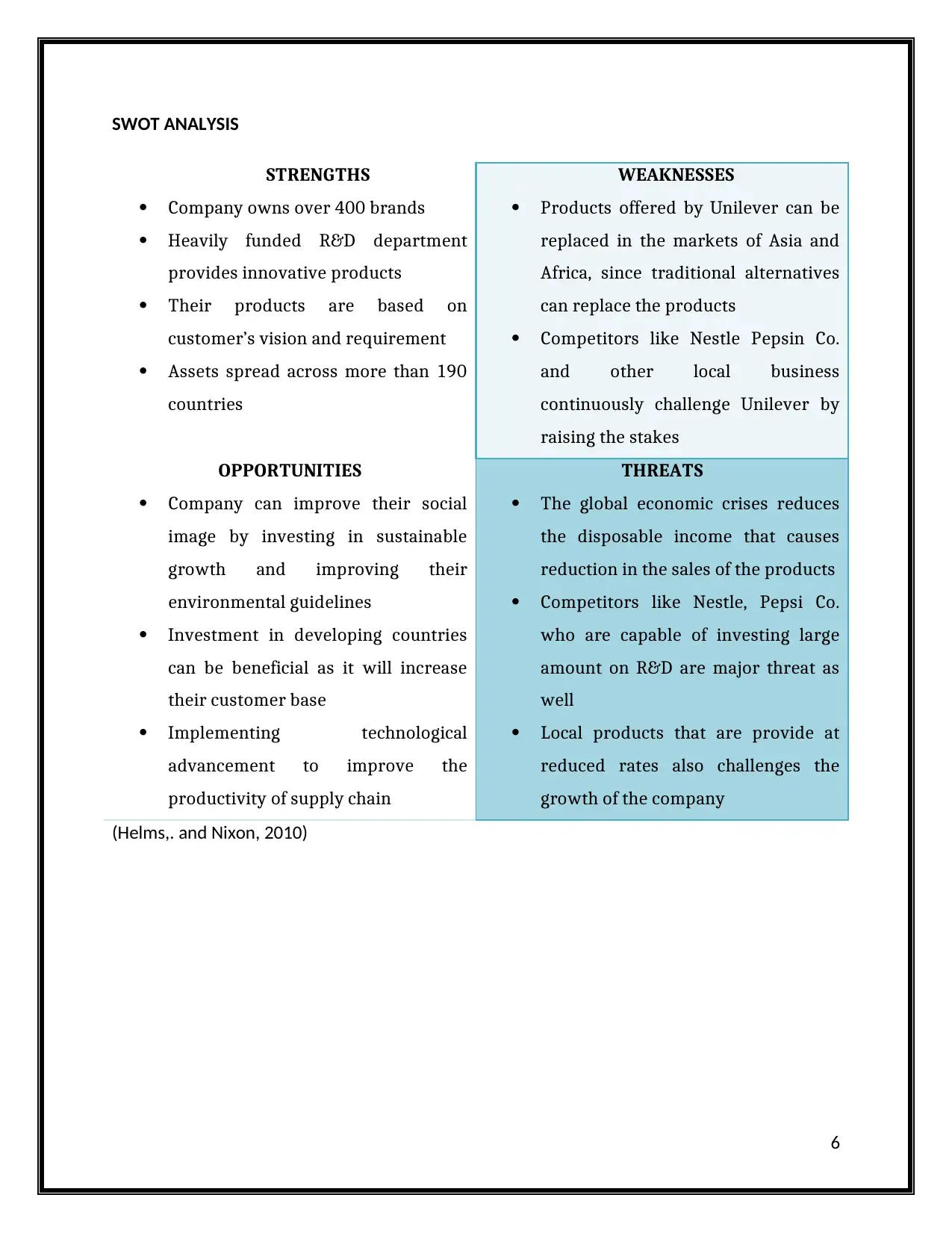
SWOT ANALYSIS
STRENGTHS
Company owns over 400 brands
Heavily funded R&D department
provides innovative products
Their products are based on
customer’s vision and requirement
Assets spread across more than 190
countries
WEAKNESSES
Products offered by Unilever can be
replaced in the markets of Asia and
Africa, since traditional alternatives
can replace the products
Competitors like Nestle Pepsin Co.
and other local business
continuously challenge Unilever by
raising the stakes
OPPORTUNITIES
Company can improve their social
image by investing in sustainable
growth and improving their
environmental guidelines
Investment in developing countries
can be beneficial as it will increase
their customer base
Implementing technological
advancement to improve the
productivity of supply chain
THREATS
The global economic crises reduces
the disposable income that causes
reduction in the sales of the products
Competitors like Nestle, Pepsi Co.
who are capable of investing large
amount on R&D are major threat as
well
Local products that are provide at
reduced rates also challenges the
growth of the company
(Helms,. and Nixon, 2010)
6
STRENGTHS
Company owns over 400 brands
Heavily funded R&D department
provides innovative products
Their products are based on
customer’s vision and requirement
Assets spread across more than 190
countries
WEAKNESSES
Products offered by Unilever can be
replaced in the markets of Asia and
Africa, since traditional alternatives
can replace the products
Competitors like Nestle Pepsin Co.
and other local business
continuously challenge Unilever by
raising the stakes
OPPORTUNITIES
Company can improve their social
image by investing in sustainable
growth and improving their
environmental guidelines
Investment in developing countries
can be beneficial as it will increase
their customer base
Implementing technological
advancement to improve the
productivity of supply chain
THREATS
The global economic crises reduces
the disposable income that causes
reduction in the sales of the products
Competitors like Nestle, Pepsi Co.
who are capable of investing large
amount on R&D are major threat as
well
Local products that are provide at
reduced rates also challenges the
growth of the company
(Helms,. and Nixon, 2010)
6
Paraphrase This Document
Need a fresh take? Get an instant paraphrase of this document with our AI Paraphraser
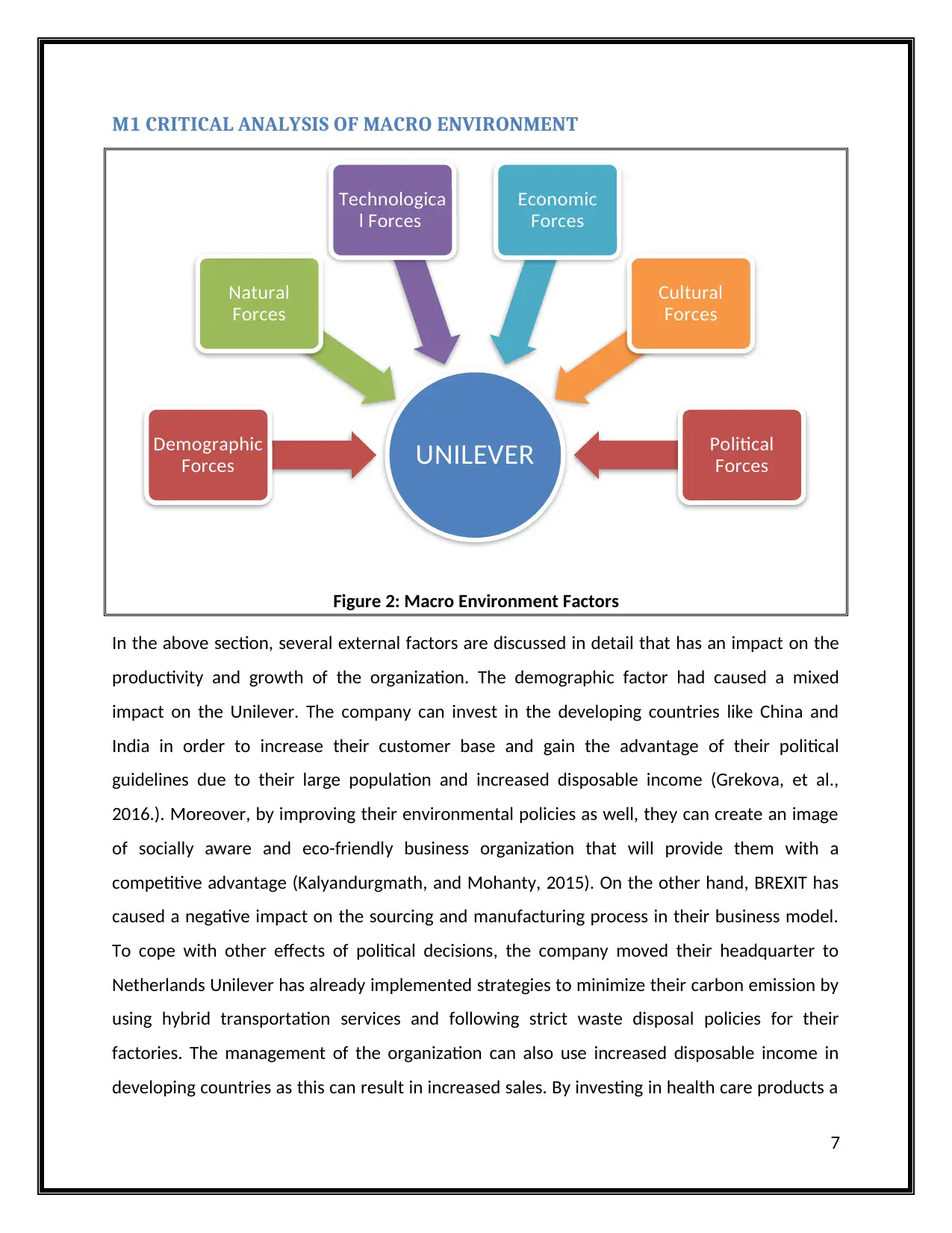
M1 CRITICAL ANALYSIS OF MACRO ENVIRONMENT
Figure 2: Macro Environment Factors
In the above section, several external factors are discussed in detail that has an impact on the
productivity and growth of the organization. The demographic factor had caused a mixed
impact on the Unilever. The company can invest in the developing countries like China and
India in order to increase their customer base and gain the advantage of their political
guidelines due to their large population and increased disposable income (Grekova, et al.,
2016.). Moreover, by improving their environmental policies as well, they can create an image
of socially aware and eco-friendly business organization that will provide them with a
competitive advantage (Kalyandurgmath, and Mohanty, 2015). On the other hand, BREXIT has
caused a negative impact on the sourcing and manufacturing process in their business model.
To cope with other effects of political decisions, the company moved their headquarter to
Netherlands Unilever has already implemented strategies to minimize their carbon emission by
using hybrid transportation services and following strict waste disposal policies for their
factories. The management of the organization can also use increased disposable income in
developing countries as this can result in increased sales. By investing in health care products a
7
UNILEVERDemographic
Forces
Natural
Forces
Technologica
l Forces
Economic
Forces
Cultural
Forces
Political
Forces
Figure 2: Macro Environment Factors
In the above section, several external factors are discussed in detail that has an impact on the
productivity and growth of the organization. The demographic factor had caused a mixed
impact on the Unilever. The company can invest in the developing countries like China and
India in order to increase their customer base and gain the advantage of their political
guidelines due to their large population and increased disposable income (Grekova, et al.,
2016.). Moreover, by improving their environmental policies as well, they can create an image
of socially aware and eco-friendly business organization that will provide them with a
competitive advantage (Kalyandurgmath, and Mohanty, 2015). On the other hand, BREXIT has
caused a negative impact on the sourcing and manufacturing process in their business model.
To cope with other effects of political decisions, the company moved their headquarter to
Netherlands Unilever has already implemented strategies to minimize their carbon emission by
using hybrid transportation services and following strict waste disposal policies for their
factories. The management of the organization can also use increased disposable income in
developing countries as this can result in increased sales. By investing in health care products a
7
UNILEVERDemographic
Forces
Natural
Forces
Technologica
l Forces
Economic
Forces
Cultural
Forces
Political
Forces
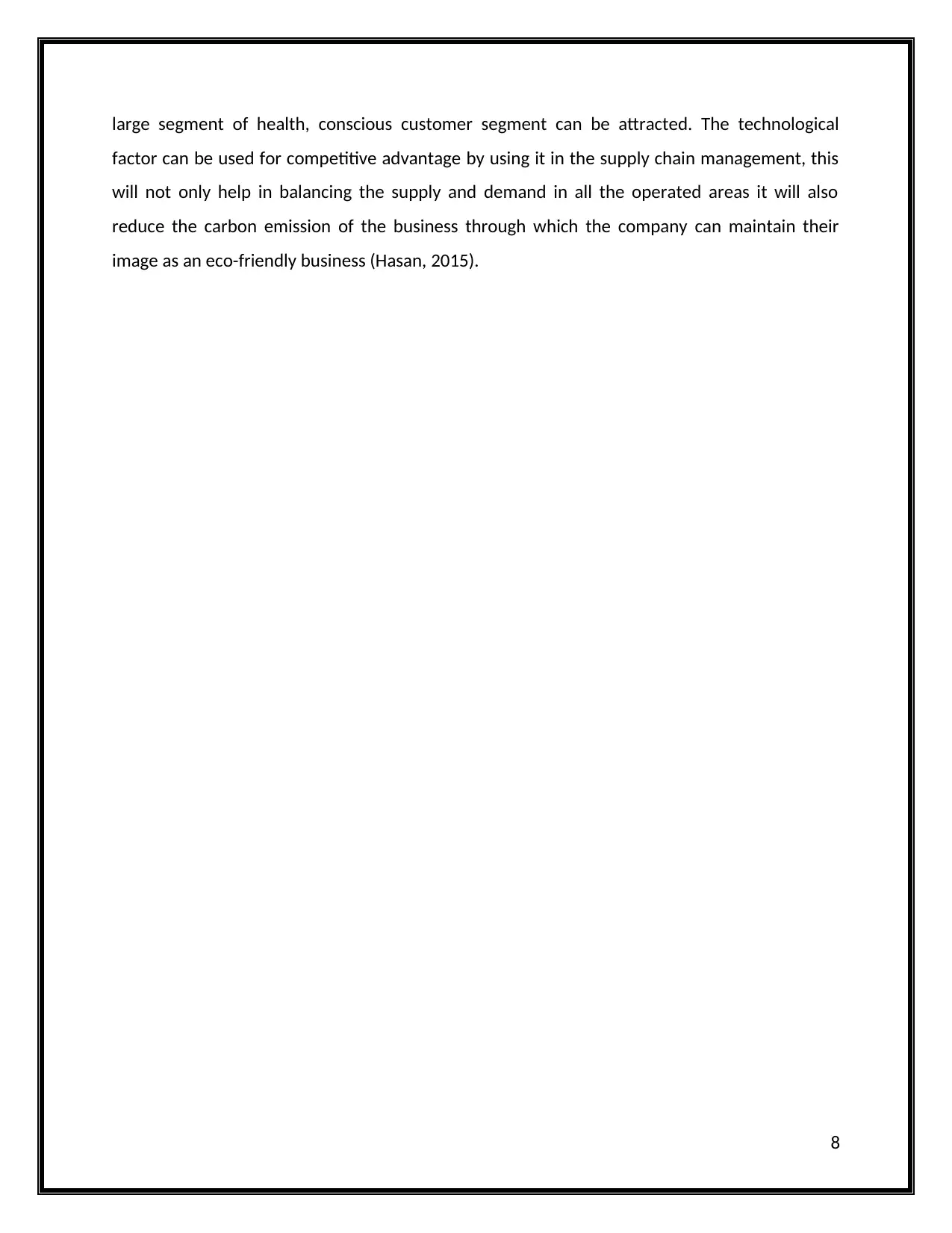
large segment of health, conscious customer segment can be attracted. The technological
factor can be used for competitive advantage by using it in the supply chain management, this
will not only help in balancing the supply and demand in all the operated areas it will also
reduce the carbon emission of the business through which the company can maintain their
image as an eco-friendly business (Hasan, 2015).
8
factor can be used for competitive advantage by using it in the supply chain management, this
will not only help in balancing the supply and demand in all the operated areas it will also
reduce the carbon emission of the business through which the company can maintain their
image as an eco-friendly business (Hasan, 2015).
8

TASK 2
P2 & M2 ANALYSIS OF INTERNAL ENVIRONMENT AND CAPABILITIES OF
UNILEVER
Unilever has several competitors including Colgate Palmolive, Kerry Group, Nestle, and local
retailers. Nestle is considered to be a sound competitor of Unilever as it operates in a wider
sector and provides comparatively broader range of products. Unilever has to conduct
stakeholder analysis that will help them in determining the impact of their decisions on
shareholders. Investments made by the shareholders are key factor for expanding the business
and compete in the market (Andriof, et al., 2017). The stakeholder analysis can be conducted in
three steps that are described below:
Figure 3: Stages of Stakeholders Analysis
IDENTIFY STAKEHOLDERS
9
Understand
Key
Stakeholders
Prioritize
Identify
stakeholders
P2 & M2 ANALYSIS OF INTERNAL ENVIRONMENT AND CAPABILITIES OF
UNILEVER
Unilever has several competitors including Colgate Palmolive, Kerry Group, Nestle, and local
retailers. Nestle is considered to be a sound competitor of Unilever as it operates in a wider
sector and provides comparatively broader range of products. Unilever has to conduct
stakeholder analysis that will help them in determining the impact of their decisions on
shareholders. Investments made by the shareholders are key factor for expanding the business
and compete in the market (Andriof, et al., 2017). The stakeholder analysis can be conducted in
three steps that are described below:
Figure 3: Stages of Stakeholders Analysis
IDENTIFY STAKEHOLDERS
9
Understand
Key
Stakeholders
Prioritize
Identify
stakeholders
Secure Best Marks with AI Grader
Need help grading? Try our AI Grader for instant feedback on your assignments.

Identification of potential stakeholders can be done by analysing the individuals that are
affected or are interested in business. These may include alliance partners, team members,
staffs, consumers, suppliers, government, shareholders and many more (Miles, 2017).
PRIORITIZE
After identification, the stakeholders have to be prioritized based on based on their loyalty
towards the company and total investment they can make. From highest to lowest priority,
Unilever’s stakeholders are Consumers, employees, investors, suppliers, and communities
(Tricker, and Tricker, 2015).
Figure 4: Power- Interest Graph for Prioritizing Stakeholders
[Source: Thompson, 2018]
To get a better understanding, critical analysis of internal environment of Unilever is conducted,
which are described below:
10
affected or are interested in business. These may include alliance partners, team members,
staffs, consumers, suppliers, government, shareholders and many more (Miles, 2017).
PRIORITIZE
After identification, the stakeholders have to be prioritized based on based on their loyalty
towards the company and total investment they can make. From highest to lowest priority,
Unilever’s stakeholders are Consumers, employees, investors, suppliers, and communities
(Tricker, and Tricker, 2015).
Figure 4: Power- Interest Graph for Prioritizing Stakeholders
[Source: Thompson, 2018]
To get a better understanding, critical analysis of internal environment of Unilever is conducted,
which are described below:
10

STRATEGIC CAPABILITY
The ability of a company to employ different plans to ensure its sustainable growth in a
competitive environment is termed as its strategic capability. This is highly dependent on the
core concepts such as business foundations, cost efficiency of the products, sustainability,
organizational knowledge, market analysis, and development objectives and goals of the
organization. Unilever uses, financial, physical, intellectual properties to provide effective
strategic methods. The tangible and intangible resources of Unilever spread across 190
countries are also needed to be identified. The strategic management of the Unilever is majorly
dependent on the needs of the customers along with the competitive strategies. Decisions
involving management, marketing HR and supply chain are affected by the core capabilities of
Unilever. Skilled and experienced people are responsible for Unilever to take ternary decisions,
whereas, major decisions regarding the operational strategies are taken by the board of
directors (Rothaermel, 2015).
VRIO MODEL
This tool is used for determining and analysing the internal resources and capabilities of the
organization, this helps is gaining competitive advantage. It consists of four questions that
determine the sustainability of the product and company (Karakowsky and Guriel, 2015).
VALUABLE
The foremost question in the model is that, is the resource valuable? I.e. is it valuable enough
to help the company in overcoming the issues. If the answer is yes then it is valuable; if not,
then it results in a competitive disadvantage. Unilever owns around 400 brands, together they
have the potential to provide an advantage during the tough competition. Additionally, the
assets or properties in 190 countries are also valuable in case of Unilever.
RARE
Is the resource rare enough? If yes then it is essential for the organization; if not then it results
in competitive parity. In case of Unilever, most of the products offered by them are replicable
that creates a competitive market (Afuah, 2014). Heavily funded Research and Development
11
The ability of a company to employ different plans to ensure its sustainable growth in a
competitive environment is termed as its strategic capability. This is highly dependent on the
core concepts such as business foundations, cost efficiency of the products, sustainability,
organizational knowledge, market analysis, and development objectives and goals of the
organization. Unilever uses, financial, physical, intellectual properties to provide effective
strategic methods. The tangible and intangible resources of Unilever spread across 190
countries are also needed to be identified. The strategic management of the Unilever is majorly
dependent on the needs of the customers along with the competitive strategies. Decisions
involving management, marketing HR and supply chain are affected by the core capabilities of
Unilever. Skilled and experienced people are responsible for Unilever to take ternary decisions,
whereas, major decisions regarding the operational strategies are taken by the board of
directors (Rothaermel, 2015).
VRIO MODEL
This tool is used for determining and analysing the internal resources and capabilities of the
organization, this helps is gaining competitive advantage. It consists of four questions that
determine the sustainability of the product and company (Karakowsky and Guriel, 2015).
VALUABLE
The foremost question in the model is that, is the resource valuable? I.e. is it valuable enough
to help the company in overcoming the issues. If the answer is yes then it is valuable; if not,
then it results in a competitive disadvantage. Unilever owns around 400 brands, together they
have the potential to provide an advantage during the tough competition. Additionally, the
assets or properties in 190 countries are also valuable in case of Unilever.
RARE
Is the resource rare enough? If yes then it is essential for the organization; if not then it results
in competitive parity. In case of Unilever, most of the products offered by them are replicable
that creates a competitive market (Afuah, 2014). Heavily funded Research and Development
11

department of Unilever works for developing new products based on the need of the
customers, this can be considered as rare since there are few competitors in the market that
are capable enough to invest largely on research and development. The brand image itself is
rare as it is well reputed due to their concern to provide sustainability.
12
customers, this can be considered as rare since there are few competitors in the market that
are capable enough to invest largely on research and development. The brand image itself is
rare as it is well reputed due to their concern to provide sustainability.
12
Paraphrase This Document
Need a fresh take? Get an instant paraphrase of this document with our AI Paraphraser
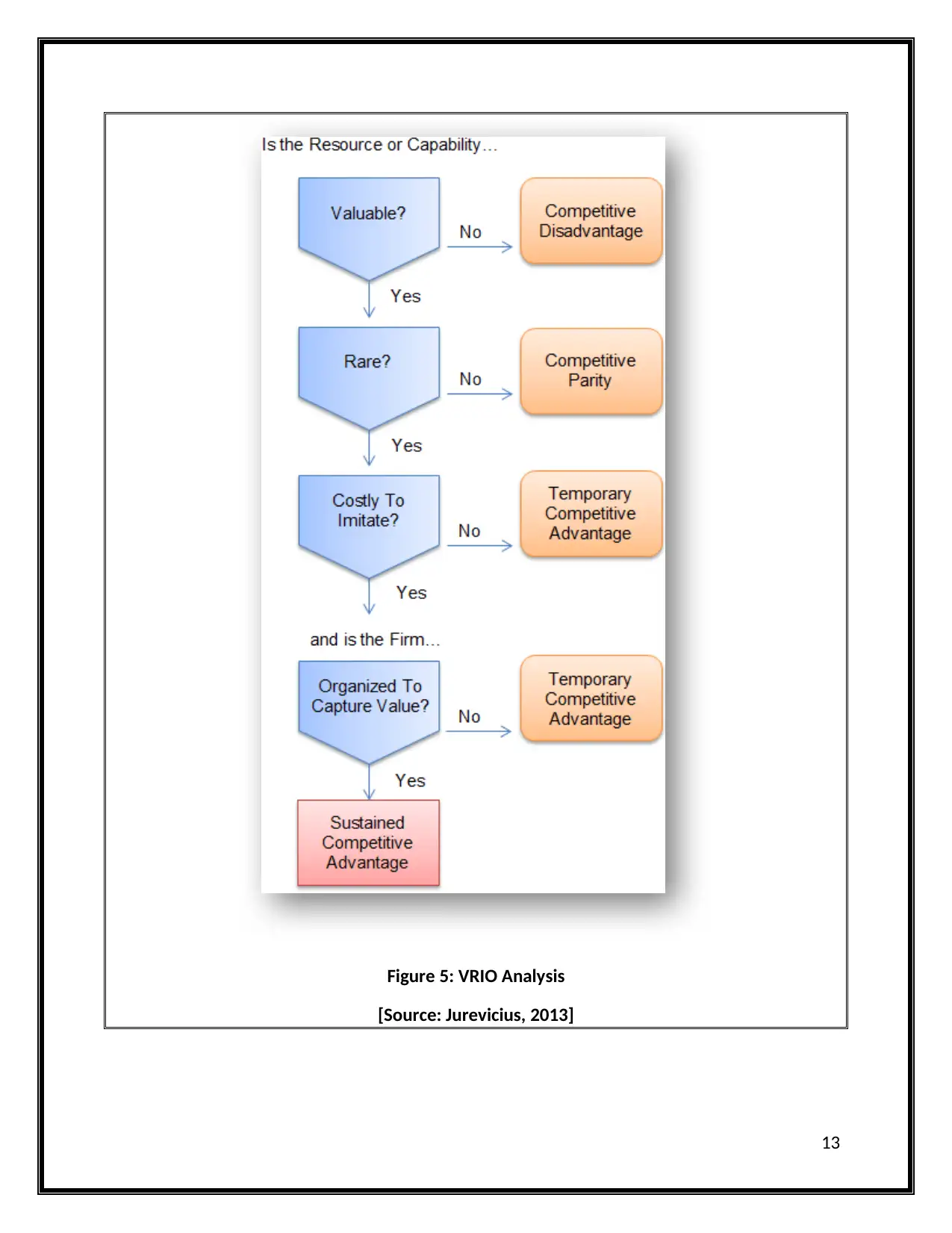
Figure 5: VRIO Analysis
[Source: Jurevicius, 2013]
13
[Source: Jurevicius, 2013]
13

COST TO IMITATE
If any resource is costly enough that competitors fail to afford it, then that resource can help
the organization during issues. Unilever's investment in their R&D department is one such
example. Another is the operating area of the company; since it is the only, retail business that
operates in around 190 countries.
ORGANIZED TO CAPTURE VALUE
The product itself is not valuable until it is properly advertised, and provided to the customers.
Unilever’s products made and marketed in a way that customer feel special for whom they are.
For instance, Dove product’s marketing is focused on making the women feel special for who
they are regardless of size, race etc. thus it can be considered that Unilever organizes their
strategies to effectively provide products in the market.
From the entire analysis, it can be concluded that relationship of Unilever with suppliers and
customers along with their strong advertisement are valuable and rare to achieve. However,
the products offered are easy to imitate, therefore Unilever's resources have a temporary
competitive advantage (Karakowsky. and Guriel, 2015).
14
If any resource is costly enough that competitors fail to afford it, then that resource can help
the organization during issues. Unilever's investment in their R&D department is one such
example. Another is the operating area of the company; since it is the only, retail business that
operates in around 190 countries.
ORGANIZED TO CAPTURE VALUE
The product itself is not valuable until it is properly advertised, and provided to the customers.
Unilever’s products made and marketed in a way that customer feel special for whom they are.
For instance, Dove product’s marketing is focused on making the women feel special for who
they are regardless of size, race etc. thus it can be considered that Unilever organizes their
strategies to effectively provide products in the market.
From the entire analysis, it can be concluded that relationship of Unilever with suppliers and
customers along with their strong advertisement are valuable and rare to achieve. However,
the products offered are easy to imitate, therefore Unilever's resources have a temporary
competitive advantage (Karakowsky. and Guriel, 2015).
14

STRENGTHS AND WEAKNESSES
Unilever is multinational company owning more than 400 brands and operates in more than
190 countries. The assets and property itself in different companies gives them competitive
advantages over many small and medium retailers (Unilever, 2017). As per the annual report of
Unilever, their continuously improvising strategy has proved to be most valuable strength of
the company. The company focuses on providing sustainable lifestyle to the people. It has
gained a reputation of eco-friendly and social organization due to its reduced carbon emission
and different strategies applied by the organization to reduce its energy consumption. The
company has gained a growth of 1.9% in total turnover compare to last year i.e. 2016. The
company has generated free cash flow of €22.1 billion in the past five years (Unilever, 2017).
The company is using dynamic mode of transportation like airways, trains compare to
depending on roads. High investment in the research and development department of the
company also provides the competitive advantage. Additionally its marketing strategy that
makes their customer feel special is another plus point of the company, since, customers feel
connected to the brand. Large variety of brands like palm oil, Walls generates profit individually
that combine goes to the Unilever. Their organizational goal is to provide better lifestyle
products to the customers at lower rates. Over the years, Unilever has successfully determined
and predicted the needs of the customers. This helps them in making loyal customers.
Implementation of technological advancement in their supply chain has reduced the workload
and provided them a tool to effectively monitor and control the supply chain (Sandberg, and
Mena, 2015).
Though there are several benefits of the organization, there exist some weaknesses that have
the potential to affect the performance and productivity of the company in the market. With
the changing global environment, new technologies are creating opportunities for local retailers
to compete with Unilever. Apart from this, competitors like Nestle, which is capable of investing
a large amount of research and development gives tough competition to the other
multinational retail industry. Lastly, though Unilever owns more than 400 brands, still, many of
15
Unilever is multinational company owning more than 400 brands and operates in more than
190 countries. The assets and property itself in different companies gives them competitive
advantages over many small and medium retailers (Unilever, 2017). As per the annual report of
Unilever, their continuously improvising strategy has proved to be most valuable strength of
the company. The company focuses on providing sustainable lifestyle to the people. It has
gained a reputation of eco-friendly and social organization due to its reduced carbon emission
and different strategies applied by the organization to reduce its energy consumption. The
company has gained a growth of 1.9% in total turnover compare to last year i.e. 2016. The
company has generated free cash flow of €22.1 billion in the past five years (Unilever, 2017).
The company is using dynamic mode of transportation like airways, trains compare to
depending on roads. High investment in the research and development department of the
company also provides the competitive advantage. Additionally its marketing strategy that
makes their customer feel special is another plus point of the company, since, customers feel
connected to the brand. Large variety of brands like palm oil, Walls generates profit individually
that combine goes to the Unilever. Their organizational goal is to provide better lifestyle
products to the customers at lower rates. Over the years, Unilever has successfully determined
and predicted the needs of the customers. This helps them in making loyal customers.
Implementation of technological advancement in their supply chain has reduced the workload
and provided them a tool to effectively monitor and control the supply chain (Sandberg, and
Mena, 2015).
Though there are several benefits of the organization, there exist some weaknesses that have
the potential to affect the performance and productivity of the company in the market. With
the changing global environment, new technologies are creating opportunities for local retailers
to compete with Unilever. Apart from this, competitors like Nestle, which is capable of investing
a large amount of research and development gives tough competition to the other
multinational retail industry. Lastly, though Unilever owns more than 400 brands, still, many of
15
Secure Best Marks with AI Grader
Need help grading? Try our AI Grader for instant feedback on your assignments.
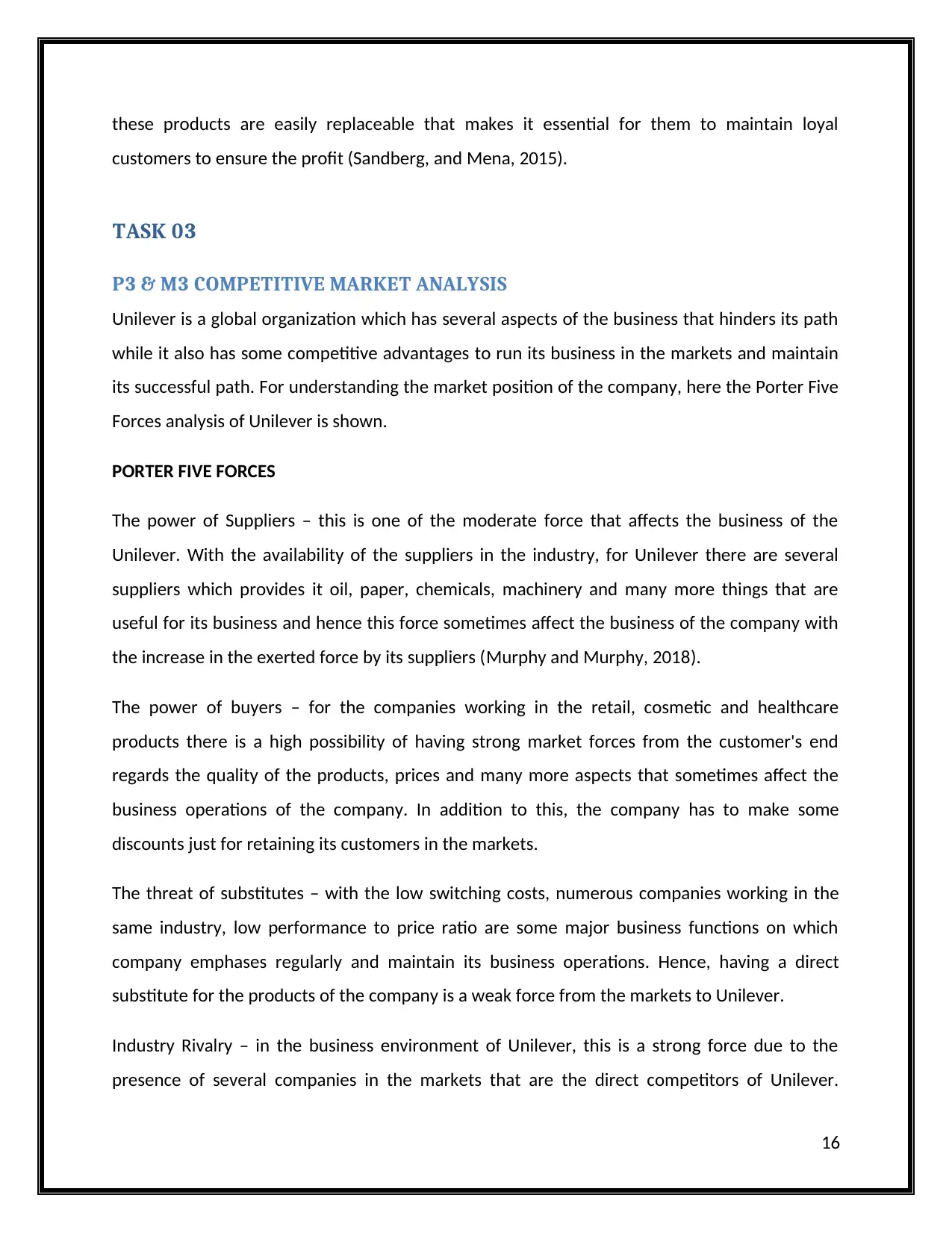
these products are easily replaceable that makes it essential for them to maintain loyal
customers to ensure the profit (Sandberg, and Mena, 2015).
TASK 03
P3 & M3 COMPETITIVE MARKET ANALYSIS
Unilever is a global organization which has several aspects of the business that hinders its path
while it also has some competitive advantages to run its business in the markets and maintain
its successful path. For understanding the market position of the company, here the Porter Five
Forces analysis of Unilever is shown.
PORTER FIVE FORCES
The power of Suppliers – this is one of the moderate force that affects the business of the
Unilever. With the availability of the suppliers in the industry, for Unilever there are several
suppliers which provides it oil, paper, chemicals, machinery and many more things that are
useful for its business and hence this force sometimes affect the business of the company with
the increase in the exerted force by its suppliers (Murphy and Murphy, 2018).
The power of buyers – for the companies working in the retail, cosmetic and healthcare
products there is a high possibility of having strong market forces from the customer's end
regards the quality of the products, prices and many more aspects that sometimes affect the
business operations of the company. In addition to this, the company has to make some
discounts just for retaining its customers in the markets.
The threat of substitutes – with the low switching costs, numerous companies working in the
same industry, low performance to price ratio are some major business functions on which
company emphases regularly and maintain its business operations. Hence, having a direct
substitute for the products of the company is a weak force from the markets to Unilever.
Industry Rivalry – in the business environment of Unilever, this is a strong force due to the
presence of several companies in the markets that are the direct competitors of Unilever.
16
customers to ensure the profit (Sandberg, and Mena, 2015).
TASK 03
P3 & M3 COMPETITIVE MARKET ANALYSIS
Unilever is a global organization which has several aspects of the business that hinders its path
while it also has some competitive advantages to run its business in the markets and maintain
its successful path. For understanding the market position of the company, here the Porter Five
Forces analysis of Unilever is shown.
PORTER FIVE FORCES
The power of Suppliers – this is one of the moderate force that affects the business of the
Unilever. With the availability of the suppliers in the industry, for Unilever there are several
suppliers which provides it oil, paper, chemicals, machinery and many more things that are
useful for its business and hence this force sometimes affect the business of the company with
the increase in the exerted force by its suppliers (Murphy and Murphy, 2018).
The power of buyers – for the companies working in the retail, cosmetic and healthcare
products there is a high possibility of having strong market forces from the customer's end
regards the quality of the products, prices and many more aspects that sometimes affect the
business operations of the company. In addition to this, the company has to make some
discounts just for retaining its customers in the markets.
The threat of substitutes – with the low switching costs, numerous companies working in the
same industry, low performance to price ratio are some major business functions on which
company emphases regularly and maintain its business operations. Hence, having a direct
substitute for the products of the company is a weak force from the markets to Unilever.
Industry Rivalry – in the business environment of Unilever, this is a strong force due to the
presence of several companies in the markets that are the direct competitors of Unilever.
16

Moreover, generally, the operational nature of the firms in this industry is aggressive which
forces the Unilever towards slow growth and high market competition.
A threat of new entries in the market – at present this force is a week force for Unilever but
with the low switching cost of customers and ease in the creation and establishing new
businesses especially for the local people, it might become a difficult task for them to handle
and manage the business growth.
STRATEGIES TO IMPROVE THE COMPETITIVE EDGE AND MARKET POSITION
Unilever is an organization with several strengths and opportunities that can foster its business
and business market. For the companies like Unilever who already have attained several goals
and objectives in their business, making strategic and competitive edge becomes an easier task.
Regarding the present condition of the company, it should focus on making its products more
valuable in the different business environments and make them their sustainable region of
gaining financial support (Teece, 2010).
With the image of a strong image, it should use the strengths of having a large product variety
and experience to avoid any business concern and dominate other businesses in the markets.
Unilever can gain a competitive edge in the markets with the help of its strong brand image,
strong product and marketing mix, a global market presence which can help it to reduce the
forces from the buyers and suppliers at the same time (Murphy and Murphy, 2018). Still, in the
future company might require some strategic fields where they can enhance the business
where some strategic tools like BCG matrix, porter generic forces etc.
17
forces the Unilever towards slow growth and high market competition.
A threat of new entries in the market – at present this force is a week force for Unilever but
with the low switching cost of customers and ease in the creation and establishing new
businesses especially for the local people, it might become a difficult task for them to handle
and manage the business growth.
STRATEGIES TO IMPROVE THE COMPETITIVE EDGE AND MARKET POSITION
Unilever is an organization with several strengths and opportunities that can foster its business
and business market. For the companies like Unilever who already have attained several goals
and objectives in their business, making strategic and competitive edge becomes an easier task.
Regarding the present condition of the company, it should focus on making its products more
valuable in the different business environments and make them their sustainable region of
gaining financial support (Teece, 2010).
With the image of a strong image, it should use the strengths of having a large product variety
and experience to avoid any business concern and dominate other businesses in the markets.
Unilever can gain a competitive edge in the markets with the help of its strong brand image,
strong product and marketing mix, a global market presence which can help it to reduce the
forces from the buyers and suppliers at the same time (Murphy and Murphy, 2018). Still, in the
future company might require some strategic fields where they can enhance the business
where some strategic tools like BCG matrix, porter generic forces etc.
17

TASK 04
EXECUTIVE SUMMARY
The current report has described a strategic plan for the Unilever in global perspective so that
they can implement the strategies shown and attain their business goals and objectives with
the development of large customer base, market value and financial resources for the
sustainable future of the company.
BACKGROUND STATEMENT
Unilever is a multinational business organization working for more than 85 years and still
operating the business successfully hence the strategic position and the market value of the
company can be evaluated through current market presence. The company has a wide variety
of products in the category of beverages, food, cleaning, personal care etc. In addition to this,
the revenue of the company is a very large number of around €53 billion. Now, the company
wants to enhance the business by focusing more on the customer relatio0ns, ethical operations
and quality products (Bell, 2013).
ORGANIZATIONAL STRUCTURE
Complete organizational structure of the company is shown below, while in addition to this, the
company is well equipped with several laws and policies to make better results in the business.
Some examples of the agreements company have made are dead of mutual covenants, mutual
guarantee borrowing, equalization agreement and many more (Uniliver, 2018). The structure
describes that the
The main focus of the company is the stakeholders as they are always being the most important
aspect of its business then comes the directors, managers and other business executives for the
company (Uniliver, 2018).
18
EXECUTIVE SUMMARY
The current report has described a strategic plan for the Unilever in global perspective so that
they can implement the strategies shown and attain their business goals and objectives with
the development of large customer base, market value and financial resources for the
sustainable future of the company.
BACKGROUND STATEMENT
Unilever is a multinational business organization working for more than 85 years and still
operating the business successfully hence the strategic position and the market value of the
company can be evaluated through current market presence. The company has a wide variety
of products in the category of beverages, food, cleaning, personal care etc. In addition to this,
the revenue of the company is a very large number of around €53 billion. Now, the company
wants to enhance the business by focusing more on the customer relatio0ns, ethical operations
and quality products (Bell, 2013).
ORGANIZATIONAL STRUCTURE
Complete organizational structure of the company is shown below, while in addition to this, the
company is well equipped with several laws and policies to make better results in the business.
Some examples of the agreements company have made are dead of mutual covenants, mutual
guarantee borrowing, equalization agreement and many more (Uniliver, 2018). The structure
describes that the
The main focus of the company is the stakeholders as they are always being the most important
aspect of its business then comes the directors, managers and other business executives for the
company (Uniliver, 2018).
18
Paraphrase This Document
Need a fresh take? Get an instant paraphrase of this document with our AI Paraphraser

Figure 6: Organizational Structure of Unilever
Source: [Uniliver, 2018]
MISSION
It is clear and simple, “to make the living place a sustainable commonplace for all, which
describes their best and long-term way to drive sustainable business” (Uniliver, 2018).
VISION
"to grow the business by taking hand in hand with the environment and increase the positive
social impact of the company via a sustainable living plan of Unilever” (Uniliver, 2018).
VALUES
Unilever has decided some most effective strategies and values for the business, which are
included in its corporate strategies. They are always ready to work with integrity, make positive
and continuous improvements, set the aspirations and work firmly with others.
MARKET ANALYSIS
19
Source: [Uniliver, 2018]
MISSION
It is clear and simple, “to make the living place a sustainable commonplace for all, which
describes their best and long-term way to drive sustainable business” (Uniliver, 2018).
VISION
"to grow the business by taking hand in hand with the environment and increase the positive
social impact of the company via a sustainable living plan of Unilever” (Uniliver, 2018).
VALUES
Unilever has decided some most effective strategies and values for the business, which are
included in its corporate strategies. They are always ready to work with integrity, make positive
and continuous improvements, set the aspirations and work firmly with others.
MARKET ANALYSIS
19
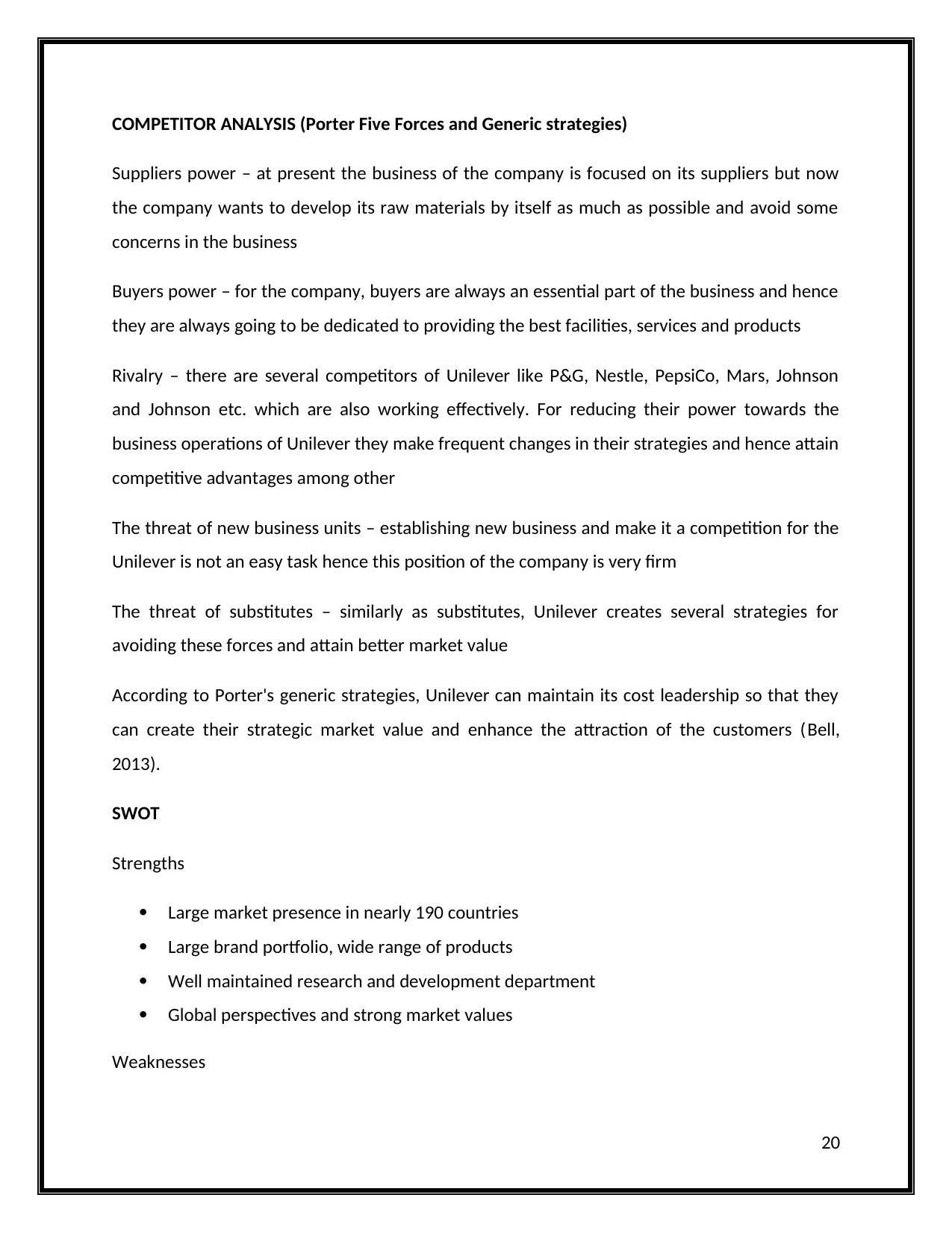
COMPETITOR ANALYSIS (Porter Five Forces and Generic strategies)
Suppliers power – at present the business of the company is focused on its suppliers but now
the company wants to develop its raw materials by itself as much as possible and avoid some
concerns in the business
Buyers power – for the company, buyers are always an essential part of the business and hence
they are always going to be dedicated to providing the best facilities, services and products
Rivalry – there are several competitors of Unilever like P&G, Nestle, PepsiCo, Mars, Johnson
and Johnson etc. which are also working effectively. For reducing their power towards the
business operations of Unilever they make frequent changes in their strategies and hence attain
competitive advantages among other
The threat of new business units – establishing new business and make it a competition for the
Unilever is not an easy task hence this position of the company is very firm
The threat of substitutes – similarly as substitutes, Unilever creates several strategies for
avoiding these forces and attain better market value
According to Porter's generic strategies, Unilever can maintain its cost leadership so that they
can create their strategic market value and enhance the attraction of the customers (Bell,
2013).
SWOT
Strengths
Large market presence in nearly 190 countries
Large brand portfolio, wide range of products
Well maintained research and development department
Global perspectives and strong market values
Weaknesses
20
Suppliers power – at present the business of the company is focused on its suppliers but now
the company wants to develop its raw materials by itself as much as possible and avoid some
concerns in the business
Buyers power – for the company, buyers are always an essential part of the business and hence
they are always going to be dedicated to providing the best facilities, services and products
Rivalry – there are several competitors of Unilever like P&G, Nestle, PepsiCo, Mars, Johnson
and Johnson etc. which are also working effectively. For reducing their power towards the
business operations of Unilever they make frequent changes in their strategies and hence attain
competitive advantages among other
The threat of new business units – establishing new business and make it a competition for the
Unilever is not an easy task hence this position of the company is very firm
The threat of substitutes – similarly as substitutes, Unilever creates several strategies for
avoiding these forces and attain better market value
According to Porter's generic strategies, Unilever can maintain its cost leadership so that they
can create their strategic market value and enhance the attraction of the customers (Bell,
2013).
SWOT
Strengths
Large market presence in nearly 190 countries
Large brand portfolio, wide range of products
Well maintained research and development department
Global perspectives and strong market values
Weaknesses
20

Numerous competitors
Easily replaceable products by others in the industry
Threats
Global economic crisis
Competition from local businesses
Low focus on CSR activities
Opportunities
Proliferation of the products and services through global social media
Attracting large group of customers
On focusing health-conscious consumers
PORTFOLIO ANALYSIS (BCG)
Question Marks – food segment
Stars – personal care segment products
Cash Cows – home care and refreshment products
Dogs – no products respected to global markets (Kasi, 2017)
KEY STRATEGIC GOALS
To create better future for the kids all around the world
Healthier living environment for healthier future
Support farming and the farmers
Reduce carbon footprints from the environment
SMART OBJECTIVES
Specific – towards environment safety and healthier living place for all
Measurable – through the high market value and customer base in future
21
Easily replaceable products by others in the industry
Threats
Global economic crisis
Competition from local businesses
Low focus on CSR activities
Opportunities
Proliferation of the products and services through global social media
Attracting large group of customers
On focusing health-conscious consumers
PORTFOLIO ANALYSIS (BCG)
Question Marks – food segment
Stars – personal care segment products
Cash Cows – home care and refreshment products
Dogs – no products respected to global markets (Kasi, 2017)
KEY STRATEGIC GOALS
To create better future for the kids all around the world
Healthier living environment for healthier future
Support farming and the farmers
Reduce carbon footprints from the environment
SMART OBJECTIVES
Specific – towards environment safety and healthier living place for all
Measurable – through the high market value and customer base in future
21
Secure Best Marks with AI Grader
Need help grading? Try our AI Grader for instant feedback on your assignments.
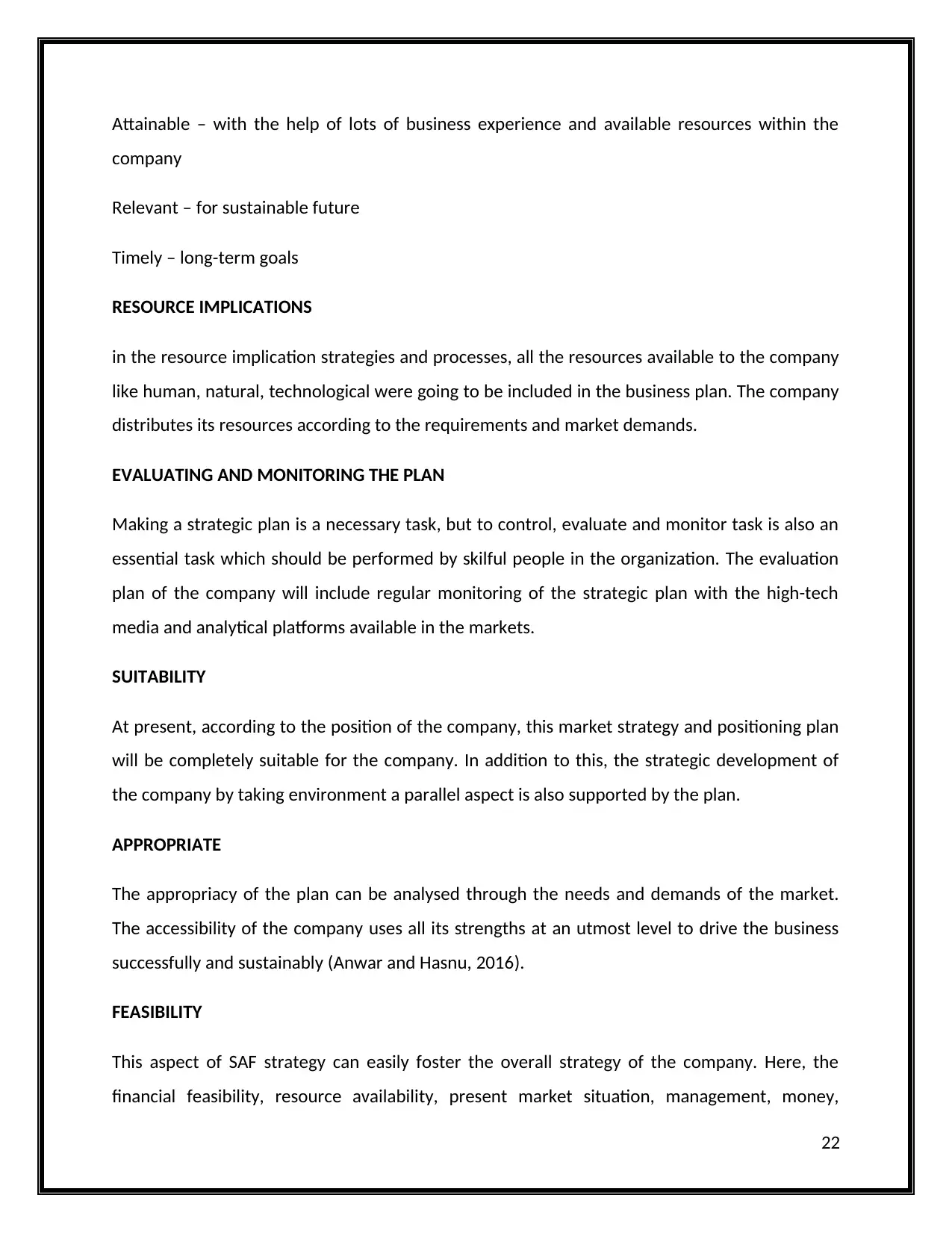
Attainable – with the help of lots of business experience and available resources within the
company
Relevant – for sustainable future
Timely – long-term goals
RESOURCE IMPLICATIONS
in the resource implication strategies and processes, all the resources available to the company
like human, natural, technological were going to be included in the business plan. The company
distributes its resources according to the requirements and market demands.
EVALUATING AND MONITORING THE PLAN
Making a strategic plan is a necessary task, but to control, evaluate and monitor task is also an
essential task which should be performed by skilful people in the organization. The evaluation
plan of the company will include regular monitoring of the strategic plan with the high-tech
media and analytical platforms available in the markets.
SUITABILITY
At present, according to the position of the company, this market strategy and positioning plan
will be completely suitable for the company. In addition to this, the strategic development of
the company by taking environment a parallel aspect is also supported by the plan.
APPROPRIATE
The appropriacy of the plan can be analysed through the needs and demands of the market.
The accessibility of the company uses all its strengths at an utmost level to drive the business
successfully and sustainably (Anwar and Hasnu, 2016).
FEASIBILITY
This aspect of SAF strategy can easily foster the overall strategy of the company. Here, the
financial feasibility, resource availability, present market situation, management, money,
22
company
Relevant – for sustainable future
Timely – long-term goals
RESOURCE IMPLICATIONS
in the resource implication strategies and processes, all the resources available to the company
like human, natural, technological were going to be included in the business plan. The company
distributes its resources according to the requirements and market demands.
EVALUATING AND MONITORING THE PLAN
Making a strategic plan is a necessary task, but to control, evaluate and monitor task is also an
essential task which should be performed by skilful people in the organization. The evaluation
plan of the company will include regular monitoring of the strategic plan with the high-tech
media and analytical platforms available in the markets.
SUITABILITY
At present, according to the position of the company, this market strategy and positioning plan
will be completely suitable for the company. In addition to this, the strategic development of
the company by taking environment a parallel aspect is also supported by the plan.
APPROPRIATE
The appropriacy of the plan can be analysed through the needs and demands of the market.
The accessibility of the company uses all its strengths at an utmost level to drive the business
successfully and sustainably (Anwar and Hasnu, 2016).
FEASIBILITY
This aspect of SAF strategy can easily foster the overall strategy of the company. Here, the
financial feasibility, resource availability, present market situation, management, money,
22

manpower is all included so that the company enable each and every single opportunity
present for Unilever.
23
present for Unilever.
23
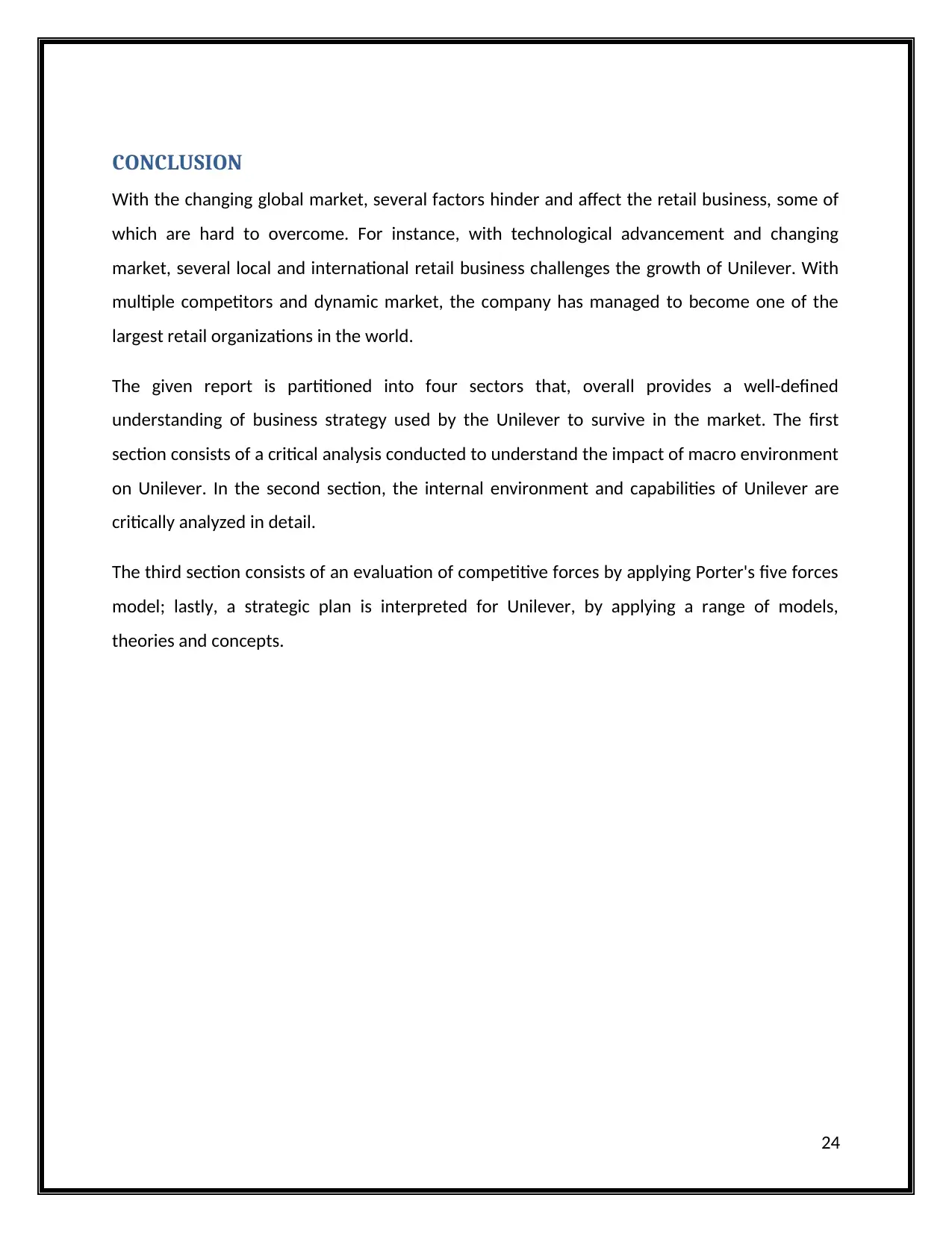
CONCLUSION
With the changing global market, several factors hinder and affect the retail business, some of
which are hard to overcome. For instance, with technological advancement and changing
market, several local and international retail business challenges the growth of Unilever. With
multiple competitors and dynamic market, the company has managed to become one of the
largest retail organizations in the world.
The given report is partitioned into four sectors that, overall provides a well-defined
understanding of business strategy used by the Unilever to survive in the market. The first
section consists of a critical analysis conducted to understand the impact of macro environment
on Unilever. In the second section, the internal environment and capabilities of Unilever are
critically analyzed in detail.
The third section consists of an evaluation of competitive forces by applying Porter's five forces
model; lastly, a strategic plan is interpreted for Unilever, by applying a range of models,
theories and concepts.
24
With the changing global market, several factors hinder and affect the retail business, some of
which are hard to overcome. For instance, with technological advancement and changing
market, several local and international retail business challenges the growth of Unilever. With
multiple competitors and dynamic market, the company has managed to become one of the
largest retail organizations in the world.
The given report is partitioned into four sectors that, overall provides a well-defined
understanding of business strategy used by the Unilever to survive in the market. The first
section consists of a critical analysis conducted to understand the impact of macro environment
on Unilever. In the second section, the internal environment and capabilities of Unilever are
critically analyzed in detail.
The third section consists of an evaluation of competitive forces by applying Porter's five forces
model; lastly, a strategic plan is interpreted for Unilever, by applying a range of models,
theories and concepts.
24
Paraphrase This Document
Need a fresh take? Get an instant paraphrase of this document with our AI Paraphraser

REFERENCES
1. Afuah, A., 2014. Business model innovation: concepts, analysis, and cases. Routledge.
2. Andriof, J., Waddock, S., Husted, B. and Rahman, S.S., 2017. Unfolding stakeholder
thinking: theory, responsibility and engagement. Routledge.
3. Anwar, J. and Hasnu, S.A.F., 2016. Business strategy and firm performance: a multi-
industry analysis. Journal of Strategy and Management, 9(3), pp.361-382.
4. Cadle, J., Paul, D. and Turner, P., 2010. Business analysis techniques: 72 essential tools
for success. BCS, The Chartered Institute.
5. Financial Times, 2018, Unilever’s move is not all about Brexit, but . . ., [online available
at: https://www.ft.com/content/06c972b4-2842-11e8-b27e-cc62a39d57a0] [last
accessed on: 17 May 2018]
6. Gareth Bell, I., 2013. Doing well by doing good: an interview with Paul Polman, CEO of
Unilever, part 1. Strategic Direction, 29(4), pp.38-40.
7. Grekova, K., Calantone, R.J., Bremmers, H.J., Trienekens, J.H. and Omta, S.W.F., 2016.
How environmental collaboration with suppliers and customers influences firm
performance: evidence from Dutch food and beverage processors. Journal of cleaner
production, 112, pp.1861-1871.
8. Hasan, M.M., 2015. Marketing Analysis of Unilever. Total Quality Management, 11, p.13.
9. Helms, M.M. and Nixon, J., 2010. Exploring SWOT analysis–where are we now? A review
of academic research from the last decade. Journal of strategy and management, 3(3),
pp.215-251.
10. Jurevicius, O., 2013, VRIO Framework [online available at:
https://www.strategicmanagementinsight.com/tools/vrio.html ] [last accessed on: 17
May 2018]
11. Kalyandurgmath, K. and Mohanty, R.N., 2015. ASBM Journal of Management. Journal of
Management, 8(2), pp.78-92.
12. Karakowsky, L. and Guriel, N., 2015. The context of business: Understanding the
Canadian business environment. W. Ross MacDonald School Resource Services Library.
25
1. Afuah, A., 2014. Business model innovation: concepts, analysis, and cases. Routledge.
2. Andriof, J., Waddock, S., Husted, B. and Rahman, S.S., 2017. Unfolding stakeholder
thinking: theory, responsibility and engagement. Routledge.
3. Anwar, J. and Hasnu, S.A.F., 2016. Business strategy and firm performance: a multi-
industry analysis. Journal of Strategy and Management, 9(3), pp.361-382.
4. Cadle, J., Paul, D. and Turner, P., 2010. Business analysis techniques: 72 essential tools
for success. BCS, The Chartered Institute.
5. Financial Times, 2018, Unilever’s move is not all about Brexit, but . . ., [online available
at: https://www.ft.com/content/06c972b4-2842-11e8-b27e-cc62a39d57a0] [last
accessed on: 17 May 2018]
6. Gareth Bell, I., 2013. Doing well by doing good: an interview with Paul Polman, CEO of
Unilever, part 1. Strategic Direction, 29(4), pp.38-40.
7. Grekova, K., Calantone, R.J., Bremmers, H.J., Trienekens, J.H. and Omta, S.W.F., 2016.
How environmental collaboration with suppliers and customers influences firm
performance: evidence from Dutch food and beverage processors. Journal of cleaner
production, 112, pp.1861-1871.
8. Hasan, M.M., 2015. Marketing Analysis of Unilever. Total Quality Management, 11, p.13.
9. Helms, M.M. and Nixon, J., 2010. Exploring SWOT analysis–where are we now? A review
of academic research from the last decade. Journal of strategy and management, 3(3),
pp.215-251.
10. Jurevicius, O., 2013, VRIO Framework [online available at:
https://www.strategicmanagementinsight.com/tools/vrio.html ] [last accessed on: 17
May 2018]
11. Kalyandurgmath, K. and Mohanty, R.N., 2015. ASBM Journal of Management. Journal of
Management, 8(2), pp.78-92.
12. Karakowsky, L. and Guriel, N., 2015. The context of business: Understanding the
Canadian business environment. W. Ross MacDonald School Resource Services Library.
25
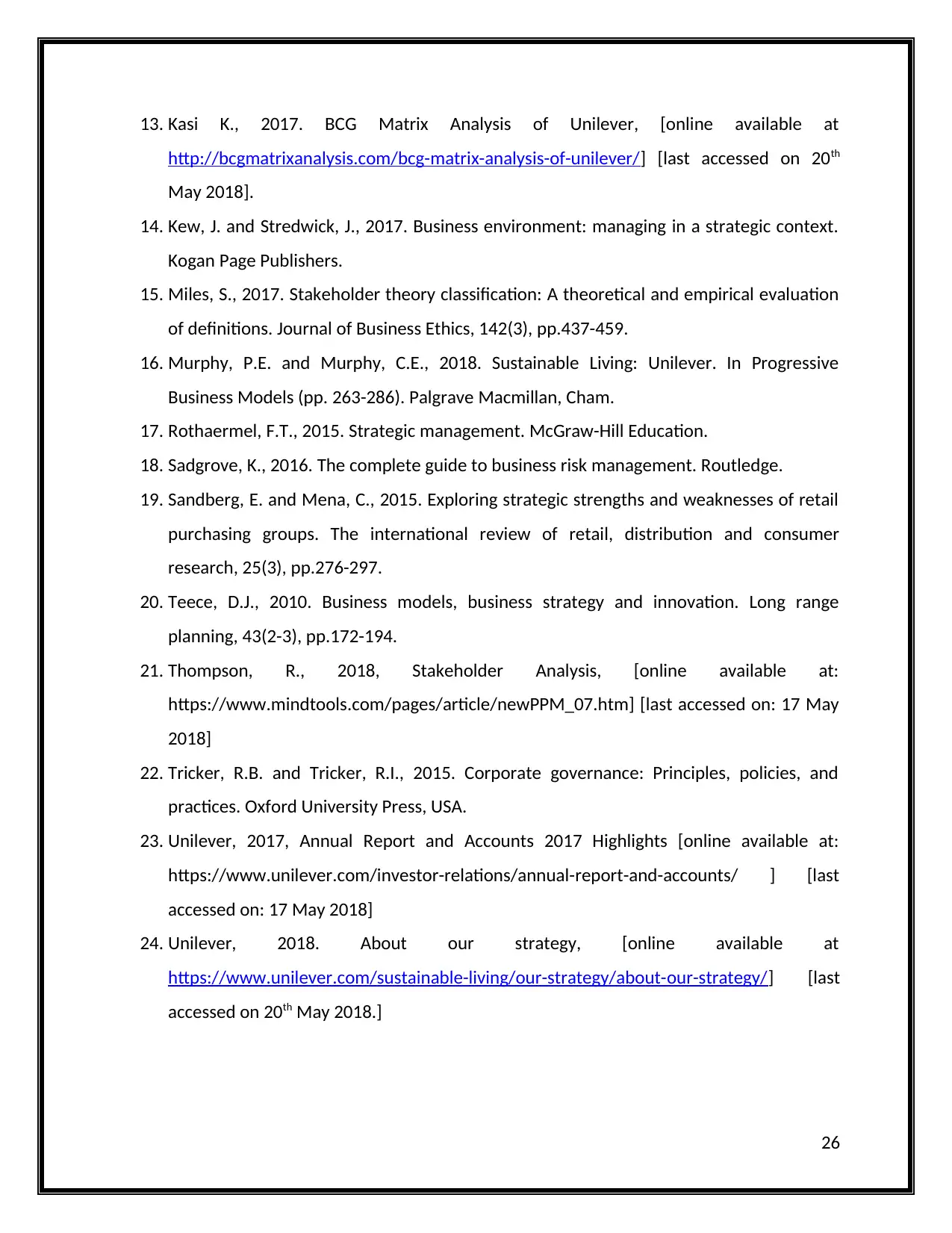
13. Kasi K., 2017. BCG Matrix Analysis of Unilever, [online available at
http://bcgmatrixanalysis.com/bcg-matrix-analysis-of-unilever/] [last accessed on 20th
May 2018].
14. Kew, J. and Stredwick, J., 2017. Business environment: managing in a strategic context.
Kogan Page Publishers.
15. Miles, S., 2017. Stakeholder theory classification: A theoretical and empirical evaluation
of definitions. Journal of Business Ethics, 142(3), pp.437-459.
16. Murphy, P.E. and Murphy, C.E., 2018. Sustainable Living: Unilever. In Progressive
Business Models (pp. 263-286). Palgrave Macmillan, Cham.
17. Rothaermel, F.T., 2015. Strategic management. McGraw-Hill Education.
18. Sadgrove, K., 2016. The complete guide to business risk management. Routledge.
19. Sandberg, E. and Mena, C., 2015. Exploring strategic strengths and weaknesses of retail
purchasing groups. The international review of retail, distribution and consumer
research, 25(3), pp.276-297.
20. Teece, D.J., 2010. Business models, business strategy and innovation. Long range
planning, 43(2-3), pp.172-194.
21. Thompson, R., 2018, Stakeholder Analysis, [online available at:
https://www.mindtools.com/pages/article/newPPM_07.htm] [last accessed on: 17 May
2018]
22. Tricker, R.B. and Tricker, R.I., 2015. Corporate governance: Principles, policies, and
practices. Oxford University Press, USA.
23. Unilever, 2017, Annual Report and Accounts 2017 Highlights [online available at:
https://www.unilever.com/investor-relations/annual-report-and-accounts/ ] [last
accessed on: 17 May 2018]
24. Unilever, 2018. About our strategy, [online available at
https://www.unilever.com/sustainable-living/our-strategy/about-our-strategy/] [last
accessed on 20th May 2018.]
26
http://bcgmatrixanalysis.com/bcg-matrix-analysis-of-unilever/] [last accessed on 20th
May 2018].
14. Kew, J. and Stredwick, J., 2017. Business environment: managing in a strategic context.
Kogan Page Publishers.
15. Miles, S., 2017. Stakeholder theory classification: A theoretical and empirical evaluation
of definitions. Journal of Business Ethics, 142(3), pp.437-459.
16. Murphy, P.E. and Murphy, C.E., 2018. Sustainable Living: Unilever. In Progressive
Business Models (pp. 263-286). Palgrave Macmillan, Cham.
17. Rothaermel, F.T., 2015. Strategic management. McGraw-Hill Education.
18. Sadgrove, K., 2016. The complete guide to business risk management. Routledge.
19. Sandberg, E. and Mena, C., 2015. Exploring strategic strengths and weaknesses of retail
purchasing groups. The international review of retail, distribution and consumer
research, 25(3), pp.276-297.
20. Teece, D.J., 2010. Business models, business strategy and innovation. Long range
planning, 43(2-3), pp.172-194.
21. Thompson, R., 2018, Stakeholder Analysis, [online available at:
https://www.mindtools.com/pages/article/newPPM_07.htm] [last accessed on: 17 May
2018]
22. Tricker, R.B. and Tricker, R.I., 2015. Corporate governance: Principles, policies, and
practices. Oxford University Press, USA.
23. Unilever, 2017, Annual Report and Accounts 2017 Highlights [online available at:
https://www.unilever.com/investor-relations/annual-report-and-accounts/ ] [last
accessed on: 17 May 2018]
24. Unilever, 2018. About our strategy, [online available at
https://www.unilever.com/sustainable-living/our-strategy/about-our-strategy/] [last
accessed on 20th May 2018.]
26

25. Unilever, 2018. Unilever's legal structure and foundation agreements, [online available
at https://www.unilever.com/investor-relations/agm-and-corporate-governance/legal-
structure-and-foundation-agreements/] [last accessed on 20th May 2018].
27
at https://www.unilever.com/investor-relations/agm-and-corporate-governance/legal-
structure-and-foundation-agreements/] [last accessed on 20th May 2018].
27
1 out of 28
Related Documents
Your All-in-One AI-Powered Toolkit for Academic Success.
+13062052269
info@desklib.com
Available 24*7 on WhatsApp / Email
![[object Object]](/_next/static/media/star-bottom.7253800d.svg)
Unlock your academic potential
© 2024 | Zucol Services PVT LTD | All rights reserved.





